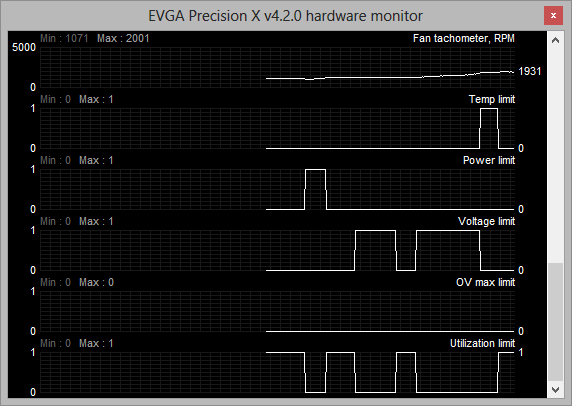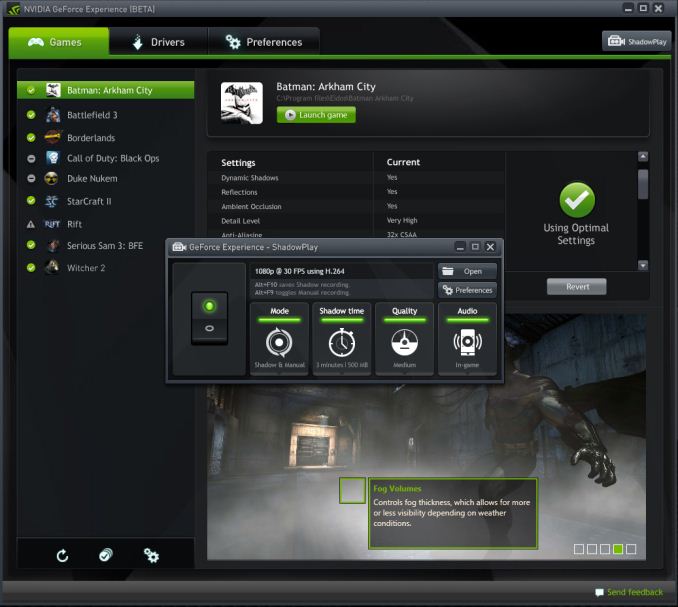NVIDIA GeForce GTX 780 Review: The New High End
by Ryan Smith on May 23, 2013 9:00 AM ESTSoftware, Cont: ShadowPlay and "Reason Flags"
Along with providing the game optimization service and SHIELD’s PC client, GeForce Experience has another service that’s scheduled to be added this summer. That service is called ShadowPlay, and not unlike SHIELD it’s intended to serve as a novel software implementation of some of the hardware functionality present in NVIDIA’s latest hardware.
ShadowPlay will be NVIDIA’s take on video recording, the novel aspect of it coming from the fact that NVIDIA is basing the utility around Kepler’s hardware H.264 encoder. To be straightforward video recording software is nothing new, as we have FRAPS, Afterburner, Precision X, and other utilities that all do basically the same thing. However all of those utilities work entirely in software, fetching frames from the GPU and then encoding them on the CPU. The overhead from this is not insignificant, especially due to the CPU time required for video encoding.
With ShadowPlay NVIDIA is looking to spur on software developers by getting into video recording themselves, and to provide superior performance by using hardware encoding. Notably this isn’t something that was impossible prior to ShadowPlay, but for some reason recording utilities that use NVIDIA’s hardware H.264 encoder have been few and far between. Regardless, the end result should be that most of the overhead is removed by relying on the hardware encoder, minimally affecting the GPU while freeing up the CPU, reducing the amount of time spent on data transit back to the CPU, and producing much smaller recordings all at the same time.
ShadowPlay will feature multiple modes. Its manual mode will be analogous to FRAPS, recording whenever the user desires it. The second mode, shadow mode, is perhaps the more peculiar mode. Because the overhead of recording with the hardware H.264 encoder is so low, NVIDIA wants to simply record everything in a very DVR-like fashion. In shadow mode the utility keeps a rolling window of the last 20 minutes of footage, with the goal being that should something happen that the user decides they want to record after the fact, they can simply pull it out of the ShadowPlay buffer and save it. It’s perhaps a bit odd from the perspective of someone who doesn’t regularly record their gaming sessions, but it’s definitely a novel use of NVIDIA’s hardware H.264 encoder.
NVIDIA hasn’t begun external beta testing of ShadowPlay yet, so for the moment all we have to work from is screenshots and descriptions. The big question right now is what the resulting quality will be like. NVIDIA’s hardware encoder does have some limitations that are necessary for real-time encoding, so as we’ve seen in the past with qualitative looks at NVIDIA’s encoder and offline H.264 encoders like x264, there is a quality tradeoff if everything has to be done in hardware in real time. As such ShadowPlay may not be the best tool for reference quality productions, but for the YouTube/Twitch.tv generation it should be more than enough.
Anyhow, ShadowPlay is expected to be released sometime this summer. But since 95% of the software ShadowPlay requires is also required for the SHIELD client, we wouldn’t be surprised if ShadowPlay was released shortly after a release quality version of the SHIELD client is pushed out, which may come as early as June alongside the SHIELD release.
Reasons: Why NVIDIA Cards Throttle
The final software announcement from NVIDIA to coincide with the launch of the GTX 780 isn’t a software product in and of itself, but rather an expansion of NVIDIA’s 3rd party hardware monitoring API.
One of the common questions/complaints about GPU Boost that NVIDIA has received over the last year is about why a card isn’t boosting as high as it should be, or why it suddenly drops down a boost bin or two for no apparent reason. For technically minded users who know the various cards’ throttle points and specifications this isn’t too complex – just look at the power consumption, GPU load, and temperature – but that’s a bit much to ask of most users. So starting with the recently released 320.14 drivers, NVIDIA is exposing a selection of flags through their API that indicate what throttle point is causing throttling or otherwise holding back the card’s clockspeed. There isn’t an official name for these flags, but “reasons” is as good as anything else, so that’s what we’re going with.

The reasons flags are a simple set of 5 binary flags that NVIDIA’s driver uses to indicate why it isn’t increasing the clockspeed of the card further. These flags are:
- Temperature Limit – the card is at its temperature throttle point
- Power Limit – The card is at its global power/TDP limit
- Voltage Limit – The card is at its highest boost bin
- Overvoltage Max Limit – The card’s absolute maximum voltage limit (“if this were to occur, you’d be at risk of frying your GPU”)
- Utilization Limit – The current workload is not high enough that boosting is necessary
As these are simple flags, it’s up to 3rd party utilities to decide how they want to present these flags. EVGA’s Precision X, which is NVIDIA’s utility of choice for sampling new features to the press, simply records the flags like it does the rest of the hardware monitoring data, and this is likely what most programs will do.
With the reason flags NVIDIA is hoping that this will help users better understand why their card isn’t boosting as high as they’d like to. At the same time the prevalence of GPU Boost 2.0 and its much higher reliance on temperature makes exposing this data all the more helpful, especially for overclockers that would like to know what attribute they need to turn up to unlock more performance.











155 Comments
View All Comments
Finally - Thursday, May 23, 2013 - link
The GTX770 is a GTX680 with a different BIOS.Degong330 - Thursday, May 23, 2013 - link
Amused to see blind fanboy comments=PaulRod - Friday, May 24, 2013 - link
Well it is... slightly tweaked core, new bios, slightly improved performance... only worth buying if you're still on a 500/6000 series card or older.YukaKun - Friday, May 24, 2013 - link
Actually, it is true... At least, for the curent PCB GTX680'sCheers!
Ninjawithagun - Monday, May 27, 2013 - link
No, Finally is correct - the GTX 770 really is a GTX680 with a different BIOS! Unfortunately, there is no way to flash an existing GTX680 to a GTX770, in spite of early reports that such a capability existed. It was found out that in fact, the BIOS that was used to flash a GTX680 to a GTX770 was in fact a fake. The BIOS was a modified GTX680 BIOS made to look as if it were a GTX770 BIOS. Confused yet? lol The bottom line is that the only difference between a GTX680 and GTX770 is the clock speeds. The GTX770 comes in at around 11-12% faster clock speeds and as such is about that much faster in frame rate rendering in games. So if you already own one or more GTX680s, it is definitely NOT worth upgrading to a GTX770!An00bis - Friday, May 31, 2013 - link
this reminds me of the 7870, differences of under 10%, about 5% clock to clock compared to a 7850 that can OC the same, and people still buy it even though it's like $50 or more expensive than a 7850, just because it comes with a 1ghz OC, compared to a 7850 that only comes at about 800mhz stock.DanNeely - Thursday, May 23, 2013 - link
The 770 is using a revised version of the chip. While we're unlikely to see a large improvement it should run slightly faster for the same TDP.Hrel - Friday, May 24, 2013 - link
500Machelios - Thursday, May 23, 2013 - link
Better value than Titan, but still very niche...I'd like to see what Nvidia and AMD can bring at $250 in their next gen cards
AssBall - Thursday, May 23, 2013 - link
Agreed. A good video card should cost about as much as a good CPU, or a good MB.